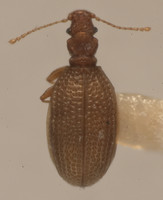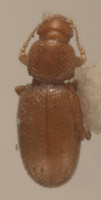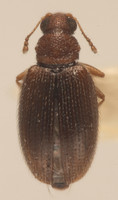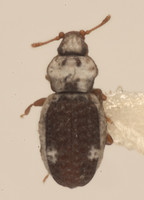Latridiidae
Minute brown scavenger beetles
Floyd W. Shockley, Christopher S. Hartley, and Nathan P. Lord- Corticariinae Curtis 1829
- Austrophthalma Dajoz 1966
- Bicava Belon 1884
- Corticaria Marsham 1802
- Corticarina Reitter 1881
- Corticaromus Pal & Ghosh 2007
- Cortinicara Johnson 1975
- Fuchsina Fall 1899
- Melanophthalma Motschulsky 1866
- Migneuxia Jacquelin du Val 1859
- Paracaria Dajoz 1970
- Rethusus Broun 1886
- Succinimontia Zherikhin 1977

- Latridiinae Erichson 1842
- Adistemia Fall 1899
- Archelatrius Kirejtshuk & Azar 2009

- Besuchetia Dajoz 1975
- Cartodere Thomson 1859
- Dicastria Dajoz 1967
- Dienerella Reitter 1911
- Enicmus Thomson 1859
- Euchionellus Reitter 1908
- Eufallia Muttkowski 1910
- Eufalloides Hinton 1941
- Herfordia Halstead 1967
- Latridius Herbst 1793
- Lithostygnus Broun 1886
- Metophthalmoides Dajoz 1967
- Metophthalmus Motschulsky 1850
- Mumfordia van Dyke 1935
- Nalpaumia Dajoz 1976
- Revelieria Perris 1869
- Stephostethus LeConte 1878
- Thes Semenov Tian-Shansky 1910
- Tetrameropsinae Kirejtshuk & Azar 2008
- Tetrameropsis Kirejtshuk & Azar 2008

- Tetrameropsis Kirejtshuk & Azar 2008
Introduction
Latridiidae, whose members are more commonly known as the Minute Brown Scavenger Beetles, is a family of very small (1-3 mm) mycophagous and myxomycophagous beetles. At present, the family includes 35 genera and approximately 1100 species (including fossil taxa). Latridiidae is divided into 3 subfamilies (2 extant and 1 extinct): Latridiinae, Corticariinae and Tetrameropsinae. Although latridiids are best known from the temperate regions of the world, the family is truly cosmopolitan with several genera widely introduced as stored product pests (e.g., Corticaria, Melanophthalma, Latridius).
Most latridiid adults and larvae feed on the conidia and hyphae of phycomycete, deuteromycete and ascomycete fungi, while a small number of species are specialists on myxomycete spores (Lawrence 1982, Lawrence 1991, Andrews 2002, Hartley and McHugh in press). Adults are most often encountered during the wetter seasons of the year and are frequently collected by beating decaying vegetation and by Berlese funnel extraction from sifted leaf litter. They are also occasionally collected in pitfall traps and light traps. Some species are known to be associated with the litter in nests of Neotoma wood rats (Hartley et al. 2007, Hartley and McHugh in press). At least 30 widespread species have been listed as stored product pests of humans (Hinton 1941), and one species, Eufallia seminiveus Motschulsky was reported to bite humans (Parsons 1969).
Characteristics
In general, adults of the family are fairly small in size and cryptically colored (brown to black) with an elongate to elongate-oval body shape. The adult forms of each extant subfamily are very distinct from one another, allowing for easy identification. Latridiidae exhibits interesting anatomical diversity, with some members exhibiting aptery or brachyptery, reduction or complete loss of eyes, elongate cylindrical trochanters and fused elytra. In general, the adults can be characterized by the combination of the following features (based on Lawrence et al. 1999a, Andrews 2002, Lord 2008, Hartley and McHugh in press):- Small size, ranging from 1-3 mm
- Elongate to elongate-oval habitus
- Antennae 10 or 11-segmented with a 2-3 segmented apical club, inserted on frons between eyes
- Tarsi 3-3-3, simple, linear (occasionally bearing a ventral lobe on tarsomere I), claws simple (appendiculate in Rethusus)
- Body surface glabrous (Latridiinae) or pubescent (Corticariinae)
- Dorsal surfaces rugosely sculptured with dorsal carinae (Latridiinae) or not rugose (Corticariinae)
- Partially to heavily covered by waxy exudates (Latridiinae) or lacking these exudates entirely (Corticariinae).
- Head with epicranial stem short to moderately long (may be absent in some), frontal arms usually V-shaped
- Frontoclypeal suture absent
- 1-5 pairs of stemmata (usually 3 or 4), occasionally absent
- Antennae 3-segmented, usually with antennomere II 1.5X length of antennomere III and 3X length of antennomere I, occasionally with antennomeres II and III subequal and each twice as long as antennomere I
- Mandibles symmetrical, unidentate to quadridentate, mola well-developed and tuberculate or aspirate, usually with a well-developed broadly rounded or acute hyaline prostheca
- Legs well-developed, 5-segmented with unisetose tarsungulus
- Lacking urogomphi
- Spiracles annular
Taxonomy
Although Corticariidae Curtis, 1829, has priority over Latridiidae Erichson, 1842 (Lawrence and Newton 1995), we have elected to use the more commonly used junior synonym. Many modern workers have argued for conservation of Latridiidae as the name of the family based on familiarity and to promote nomenclatural stability. To date, no one has assembled a proposal to the International Commission of Zoological Nomenclature for a formal ruling on this issue.
Previous taxonomic authorities included four tribes within Latridiidae: Latridiini, Corticariini, Merophysiini and Dasycerini. Crowson (1955) removed Merophysiini and Dasycerini from Latridiidae, elevated both to the family-level, and elevated the remaining two tribes (Latridiini and Corticariini) to the subfamilial-level. Subsequent workers placed Merophysiidae and Dasyceridae as subfamilies within other families, Endomychidae and Staphylinidae, respectively.
Despite the existence of several significant generic-level treatments (Belon 1902, Hetschko 1926), a lack of family-level revisions has left generic definitions relatively unstable. Over the intervening 75 years since these catalogues were published, descriptions of many new taxa, most as isolated single-species treatments has led to underestimation of the diversity of the group. Likewise, persistent confusion at the species-level continues to plague many heterogenous genera within the family. In recent years, renewed interest in latridiid systematics (e.g., Hartley et al. 2007, Johnson 2007, Lord 2008, Hartley and McHugh in press) has contributed to the resolution of some of these classification issues.
Discussion of Phylogenetic Relationships
Previous workers have argued that Latridiidae, although lacking strong synapomorphies, appears to be a natural group and may be the sister group of Corylophidae (Ślipiński and Pakaluk 1991). However, very few phylogenetic analyses have been conducted that include sufficient taxa to test the monophyly of the group or its constituent subfamilies. Recent phylogenies of higher order taxa based on molecular sequence data and including exemplar latridiid taxa have only raised questions about the monophyly of the family.
The first formal phylogenetic analysis to include latridiids was that proposed from the Bayesian analysis of 18S, 16S and COI gene sequences by Hunt et al. (2007). Although the latridiid sampling was very limited in that study, Latridiidae and both subfamilies were recovered as monophyletic. A later study focusing on the relationships of the families and subfamilies of the Cerylonid Series by Robertson et al. (2008) recovered Latridiidae and both subfamilies as monophyletic based on Bayesian analysis of 18S and 28S. Interestingly, Latridiidae was recovered as paraphyletic with respect to Discolomatidae, Corylophidae and Anamorphinae (Endomychidae) using both maximum parsimony and POY analysis, but Latridiinae and Corticariinae were both supported as monophyletic in all analyses. To date, there are no phylogenetic analyses based on morphology for Latridiidae, leaving the relationship of the extinct subfamily Tetrameropsinae to the remaining extant subfamilies unresolved.
References
Andrews, F.G. 2002. Chapter 95. Latridiidae Erichson 1842, pp. 395-398. In R. H. Arnett, M. C. Thomas, P. E. Skelley and J. H. Frank [eds.], American Beetles, Volume 2. CRC Press, Boca Raton, FL.
Belon, R. P. 1902. Coleoptera Clavicornia Fam. Lathridiidae, pp. 1-40 + 1 pl. In P. Wytsman [ed.], Genera Insectorum. P. Wytsman, Brussels.
Crowson, R.A. 1955. The Natural Classification of the Families of Coleoptera. Lloyd, London. 187 pp.
Hartley, C. and J.V. McHugh. 10.35. Latridiidae Erichson, 1842. In R.G. Beutel and R.A.B. Leschen (eds.). Handbuch der Zoologie. Band IV, Teilband 38, vol. 2. De Gruyter, Berlin. In Press.
Hartley, C., F.G. Andrews and J.V. McHugh. 2007. A revision of Akalyptoischion (Coleoptera: Cucujoidea). Patricia Vaurie Monograph Series Monograph 6. Coleopterists Society, North Potomac, MD. 50 p.
Hetschko, A. 1926. Pars 85: Lathridiidae. In S. Schenkling [ed.], Coleopterorum Catalogus. W. Junk, Berlin. 86 p.
Hinton, H.E. 1941. The Lathridiidae of economic importance. Bulletin of Entomological Research 32: 191-247.
Hunt, T., J. Bergsten, Z. Levkanicova, A. Papadopoulou, O. St. John, R. Wild, P. M. Hammond, D. Ahrens, M. Balke, M. S. Caterino, J. Gomez-Zurita, I. Ribera, T. G. Barraclough, M. Bocakova, L. Bocak, and A. P. Vogler. 2007. A comprehensive phylogeny of beetles reveals the evolutionary origins of a superradiation. Science 318: 1913-1916.
Johnson, C. 2007. Family Latridiidae Erichson, 1842, pp. 635-648. In I. Lobl and A. Smetana [eds.], Catalogue of Palaearctic Coleoptera. Volume 4. Elateroidea - Derodontoidea - Bostrichoidea - Lymexyloidea - Cleroidea - Cucujoidea. Apollo Books, Stenstrup. 935 p.
Lawrence, J. F. 1982. Lathridiidae, pp. 533-534. In S. P. Parker [ed.], Synopsis & Classification of Living Organisms. McGraw Hill, Inc., New York.
Lawrence, J. F. 1991. Lathridiidae (Cucujoidea), pp. 497-498. In F. W. Stehr [ed.], Immature Insects. Volume 2. Kendall/Hunt Publishing Company, Dubuque, IA.
Lawrence, J. F., A. M. Hastings, M. J. Dallwitz, T. A. Paine, and E. J. Zurcher 1999a. Beetles of the World: A Key and Information System for Families and Subfamilies. CD-ROM, version 1.0 for MS-Windows. CSIRO Publishing, Melbourne.
Lawrence, J. F., A. M. Hastings, M. J. Dallwitz, T. A. Paine, and E. J. Zurcher 1999b. Beetle Larvae of the World: Descriptions, Illustrations, Identification, and Information Retrieval for Families and Sub-families. CD-ROM, version 1.1 for MS-Windows. CSIRO Publishing, Melbourne.
Lawrence, J. F., and A. F. Newton. 1995. Families and subfamilies of Coleoptera (with selected genera, notes, references and data on family-group names), pp. 779-1006. In J. Pakaluk and S. A. Slipinski [eds.], Biology, Phylogeny, and Classification of Coleoptera: Papers Celebrating the 80th Birthday of Roy A. Crowson. Museum i Instytut Zoologii PAN, Warszawa.
Lord, N.P. 2008. Systematics within the Cerylonid Series (Coleoptera: Cucujoidea). Masters Thesis, University of Georgia, Athens. [unpublished]
Pakaluk, J., S. A. Slipinski, and J. F. Lawrence. 1994. Current classification and family-group names in Cucujoidea (Coleoptera). Genus 5: 223-268.
Parsons, C. T. 1969. A lathridiid beetle reported to bite man. The Coleopterists Bulletin 23: 15.
Robertson, J.A., M.F. Whiting and J.V. McHugh. 2008. Searching for natural lineages within the Cerylonid Series (Coleoptera: Cucujoidea). Molecular Phylogenetics and Evolution 46 (1): 193-205.
Ślipiński, S. A., and J. Pakaluk. 1991. Problems in the classification of the Cerylonid series of Cucujoidea (Coleoptera), pp. 79-88. In M. Zunino, X. Belles and M. Blas [eds.], Advances in Coleopterology. AEC, Barcelona.
Title Illustrations

| Scientific Name | Eufallia seminiveus |
|---|---|
| Specimen Condition | Dead Specimen |
| Identified By | C. Hartley |
| Image Use |
 This media file is licensed under the Creative Commons Attribution-NonCommercial License - Version 3.0. This media file is licensed under the Creative Commons Attribution-NonCommercial License - Version 3.0.
|
| Copyright |
© Floyd W. Shockley

|
| Scientific Name | Fuchsina arida |
|---|---|
| Specimen Condition | Dead Specimen |
| Identified By | C. Hartley |
| Image Use |
 This media file is licensed under the Creative Commons Attribution-NonCommercial License - Version 3.0. This media file is licensed under the Creative Commons Attribution-NonCommercial License - Version 3.0.
|
| Copyright |
© Floyd W. Shockley

|
| Scientific Name | Melanophthalma sp. |
|---|---|
| Specimen Condition | Dead Specimen |
| Identified By | C. Hartley |
| Image Use |
 This media file is licensed under the Creative Commons Attribution-NonCommercial License - Version 3.0. This media file is licensed under the Creative Commons Attribution-NonCommercial License - Version 3.0.
|
| Copyright |
© Floyd W. Shockley

|
| Scientific Name | Metophthalmus americanus |
|---|---|
| Specimen Condition | Dead Specimen |
| Identified By | C. Hartley |
| Image Use |
 This media file is licensed under the Creative Commons Attribution-NonCommercial License - Version 3.0. This media file is licensed under the Creative Commons Attribution-NonCommercial License - Version 3.0.
|
| Copyright |
© Floyd W. Shockley

|
About This Page
Special thanks to Dr. Joseph V. McHugh for reviewing the text and offering useful comments/suggestions. Partial support for the construction of this page was provided by the H.H. Ross Endowment of the Department of Entomology at the University of Georgia, through an NSF AToL grant EF-0531665 to M.F. Whiting (subcontract to J.V. McHugh) and through an NSF PEET grant (DEB-0329115) to J.V. McHugh, M.F. Whiting, and K.B. Miller.
Floyd W. Shockley

Dept. of Entomology, National Museum of Natural History, Smithsonian Institution
Nathan P. Lord

University of New Mexico, Albuquerque, New Mexico, USA
Correspondence regarding this page should be directed to Floyd W. Shockley at , Christopher S. Hartley at , and Nathan P. Lord at
Page copyright © 2011 Floyd W. Shockley, , and Nathan P. Lord
 Page: Tree of Life
Latridiidae. Minute brown scavenger beetles.
Authored by
Floyd W. Shockley, Christopher S. Hartley, and Nathan P. Lord.
The TEXT of this page is licensed under the
Creative Commons Attribution-NonCommercial License - Version 3.0. Note that images and other media
featured on this page are each governed by their own license, and they may or may not be available
for reuse. Click on an image or a media link to access the media data window, which provides the
relevant licensing information. For the general terms and conditions of ToL material reuse and
redistribution, please see the Tree of Life Copyright
Policies.
Page: Tree of Life
Latridiidae. Minute brown scavenger beetles.
Authored by
Floyd W. Shockley, Christopher S. Hartley, and Nathan P. Lord.
The TEXT of this page is licensed under the
Creative Commons Attribution-NonCommercial License - Version 3.0. Note that images and other media
featured on this page are each governed by their own license, and they may or may not be available
for reuse. Click on an image or a media link to access the media data window, which provides the
relevant licensing information. For the general terms and conditions of ToL material reuse and
redistribution, please see the Tree of Life Copyright
Policies.
- First online 09 September 2009
- Content changed 23 March 2011
Citing this page:
Shockley, Floyd W. , Christopher S. Hartley, and Nathan P. Lord. 2011. Latridiidae. Minute brown scavenger beetles. Version 23 March 2011. http://tolweb.org/Latridiidae/9172/2011.03.23 in The Tree of Life Web Project, http://tolweb.org/















 Go to quick links
Go to quick search
Go to navigation for this section of the ToL site
Go to detailed links for the ToL site
Go to quick links
Go to quick search
Go to navigation for this section of the ToL site
Go to detailed links for the ToL site